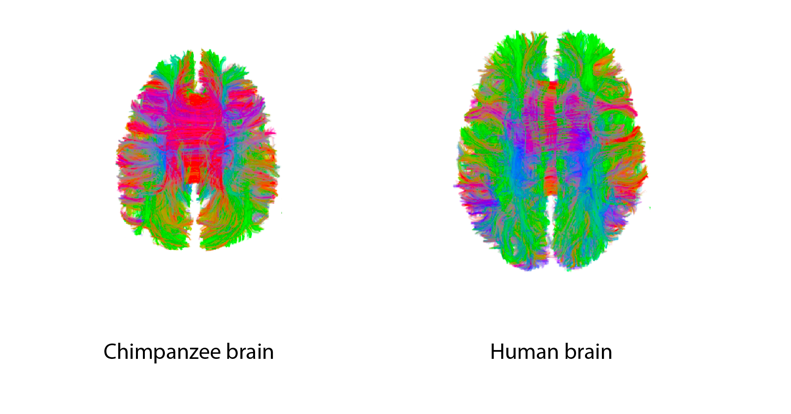
A new study of Dirk Jan Ardesch and colleagues comparing the human and chimpanzee brain provides new insight on human brain specializations, published in Proceedings of the National Academy of Sciences.
A team of VU researchers has identified patterns of human brain connectivity that are important for the evolution of complex cognition. Using a unique dataset of MRI scans of the human and chimpanzee brain, they compared the network of region-to-region brain connectivity of the two species. The study was led by Martijn van den Heuvel from the VU in Amsterdam.
What is it that makes our brain unique? Our brain is not the largest nor the most convoluted in the animal kingdom, so what is it that makes our brain capable of performing all sorts of complex brain functions? This question is crucial for our fundamental understanding of how the human brain works. The current study suggests that part of the answer lies in how our brain is connected. The complete roadmap of connections of the brain, the connectome, enables global communication between the different brain areas. This study compared the roadmap of connections of the human brain to that of the chimpanzee, our closest living evolutionary relative, and discovered that human brain wiring is more tuned to brain efficiency and information integration.
Comparing connectomes
The researchers collected MRI scans from humans and chimpanzees to reconstruct the connectomes of the two species in high detail. The MRI scans provided information on the location and trajectory of white matter fibers that make up the large-scale connectome. “Comparing the human and chimpanzee connectome, we first found – as expected – that the brain networks show large overlap across both species. This overlap is not surprising given that chimpanzees, which share a long evolutionary history with humans, are highly intelligent animals with many cognitive functions similar to ours”, says Martijn van den Heuvel. “However, when we looked in more detail, we observed subtle differences in network organization between the two species, with the human network being specifically tuned to communication efficiency between brain regions involved in information integration”. Dirk Jan Ardesch, first author on the paper, further explains: “We found stronger connections in humans between multimodal association areas. These areas are involved in complex cognitive functions, such as theory of mind and language. Connections between primary areas, including the motor cortex and primary visual cortex, were found to be relatively weaker in humans compared with chimpanzees”. The authors suggest that these differences reflect evolutionary adaptations of the human connectome, supporting the emergence of more complex cognitive functions in human evolution.
Connections of the chimpanzee and human brain, showing white matter pathways in different colors according to the direction in which they traverse the brain.
Implications of a bigger brain
The study also found that connections between the brain’s two hemispheres are weaker in humans compared with chimpanzees. “The human brain has expanded rapidly since the divergence with chimpanzees. Our data suggest that the human brain has to economize on interhemispheric connections, likely because maintaining these long-range connections in an expanding brain becomes more and more biologically expensive”, says Lianne Scholtens, a biologist also involved in the study. It is likely that weaker connectivity between the hemispheres facilitated the specialization of brain functions within each hemisphere. Language-related areas in humans show more specialized wiring patterns, which supports this idea”.
The current results provide a new step forward in our understanding of the neural underpinnings of human cognition. Martijn van den Heuvel: “The study suggests an evolutionary shift in the human connectome towards integration of multimodal information and functional specialization. These network adaptations likely played an important role in the evolution of complex cognitive functions in humans. Human network adaptations may however also have come at a price: It has been suggested that human adaptations in brain organization and connectivity may potentially be related to an increased vulnerability of certain brain disorders”.
Link to Publication:
Dirk Jan Ardesch, Lianne H. Scholtens, Longchuan Li, Todd M. Preuss, James K. Rilling, & Martijn P. van den Heuvel. Evolutionary expansion of connectivity between multimodal association areas in the human brain compared with chimpanzees. Proceedings of the National Academy of Sciences (2019), online March 18, 2019.
